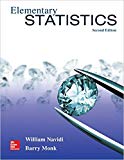
(a)
The appropriate null and alternate hypotheses.
(a)
Answer to Problem 14E
Null hypothesis:
That is,
Alternative hypothesis:
That is less than
Explanation of Solution
Given information:
In a survey of random
Based on the survey an economist claims that less than
Calculation:
Based on the survey an economist claims that less than
So null and alternate hypotheses would be given as-
Null hypothesis:
That is,
Alternative hypothesis:
That is less than
(b)
The test statistic
(b)
Answer to Problem 14E
Explanation of Solution
Given information:
In a survey of random
Based on the survey an economist claims that less than
Formula used:
Calculation:
In a survey of random
Based on the survey an economist claims that less than
So the sample proportion
Compute the test statistic
Thus, the value of test statistic is
(c)
Whether the claim made by economist is true for
(c)
Answer to Problem 14E
The economist's claim is true.
Explanation of Solution
Given information:
In a survey of random
Based on the survey an economist claims that less than
Calculation:
Obtain the critical value.
Here, the test is left-tailed and the level of significance,
From Table
Rejection rule for left-tailed test:
If
Conclusion for
The value of test statistic is
Here, the value of test statistic is lesser than the critical value.
That is
Hence, the null hypothesis is rejected.
Thus it can be concluded that less than
(d)
Whether the claim made by economist is true for
(d)
Answer to Problem 14E
The executive claim is true.
Explanation of Solution
Given information:
In a survey of random
Based on the survey an economist claims that less than
Calculation:
Obtain the critical value.
Here, the test is left-tailed and the level of significance,
From Table
Rejection rule for left-tailed test:
If
Conclusion for
The value of test statistic is
Here, the value of test statistic is lesser than the critical value.
That is
Hence, the null hypothesis is rejected.
Thus it can be concluded that less than
Want to see more full solutions like this?
Chapter 9 Solutions
Elementary Statistics 2nd Edition
- A marketing agency wants to determine whether different advertising platforms generate significantly different levels of customer engagement. The agency measures the average number of daily clicks on ads for three platforms: Social Media, Search Engines, and Email Campaigns. The agency collects data on daily clicks for each platform over a 10-day period and wants to test whether there is a statistically significant difference in the mean number of daily clicks among these platforms. Conduct ANOVA test. You can provide your answer by inserting a text box and the answer must include: also please provide a step by on getting the answers in excel Null hypothesis, Alternative hypothesis, Show answer (output table/summary table), and Conclusion based on the P value.arrow_forwardA company found that the daily sales revenue of its flagship product follows a normal distribution with a mean of $4500 and a standard deviation of $450. The company defines a "high-sales day" that is, any day with sales exceeding $4800. please provide a step by step on how to get the answers Q: What percentage of days can the company expect to have "high-sales days" or sales greater than $4800? Q: What is the sales revenue threshold for the bottom 10% of days? (please note that 10% refers to the probability/area under bell curve towards the lower tail of bell curve) Provide answers in the yellow cellsarrow_forwardBusiness Discussarrow_forward
- The following data represent total ventilation measured in liters of air per minute per square meter of body area for two independent (and randomly chosen) samples. Analyze these data using the appropriate non-parametric hypothesis testarrow_forwardeach column represents before & after measurements on the same individual. Analyze with the appropriate non-parametric hypothesis test for a paired design.arrow_forwardShould you be confident in applying your regression equation to estimate the heart rate of a python at 35°C? Why or why not?arrow_forward
 Holt Mcdougal Larson Pre-algebra: Student Edition...AlgebraISBN:9780547587776Author:HOLT MCDOUGALPublisher:HOLT MCDOUGAL
Holt Mcdougal Larson Pre-algebra: Student Edition...AlgebraISBN:9780547587776Author:HOLT MCDOUGALPublisher:HOLT MCDOUGAL Glencoe Algebra 1, Student Edition, 9780079039897...AlgebraISBN:9780079039897Author:CarterPublisher:McGraw Hill
Glencoe Algebra 1, Student Edition, 9780079039897...AlgebraISBN:9780079039897Author:CarterPublisher:McGraw Hill


